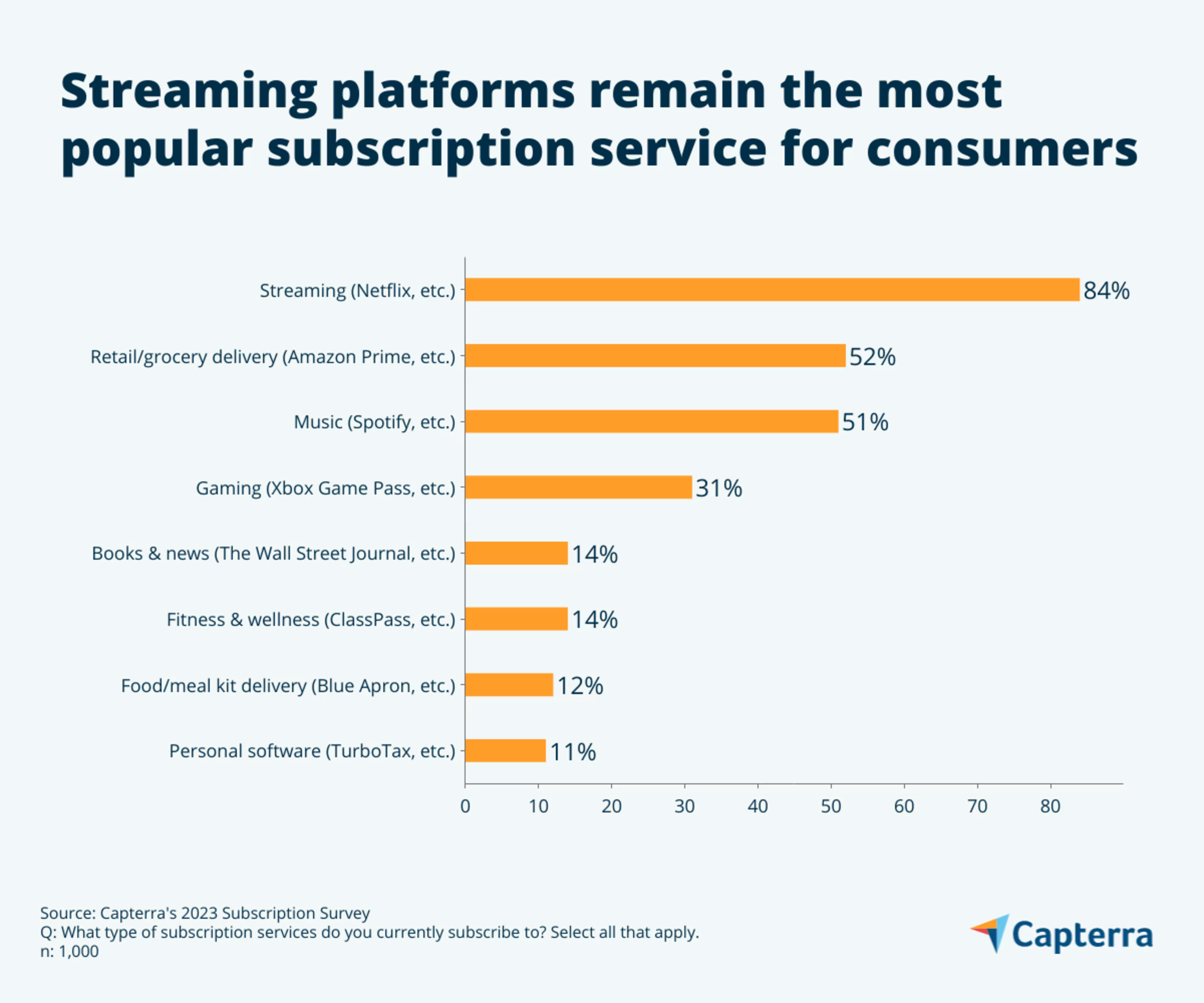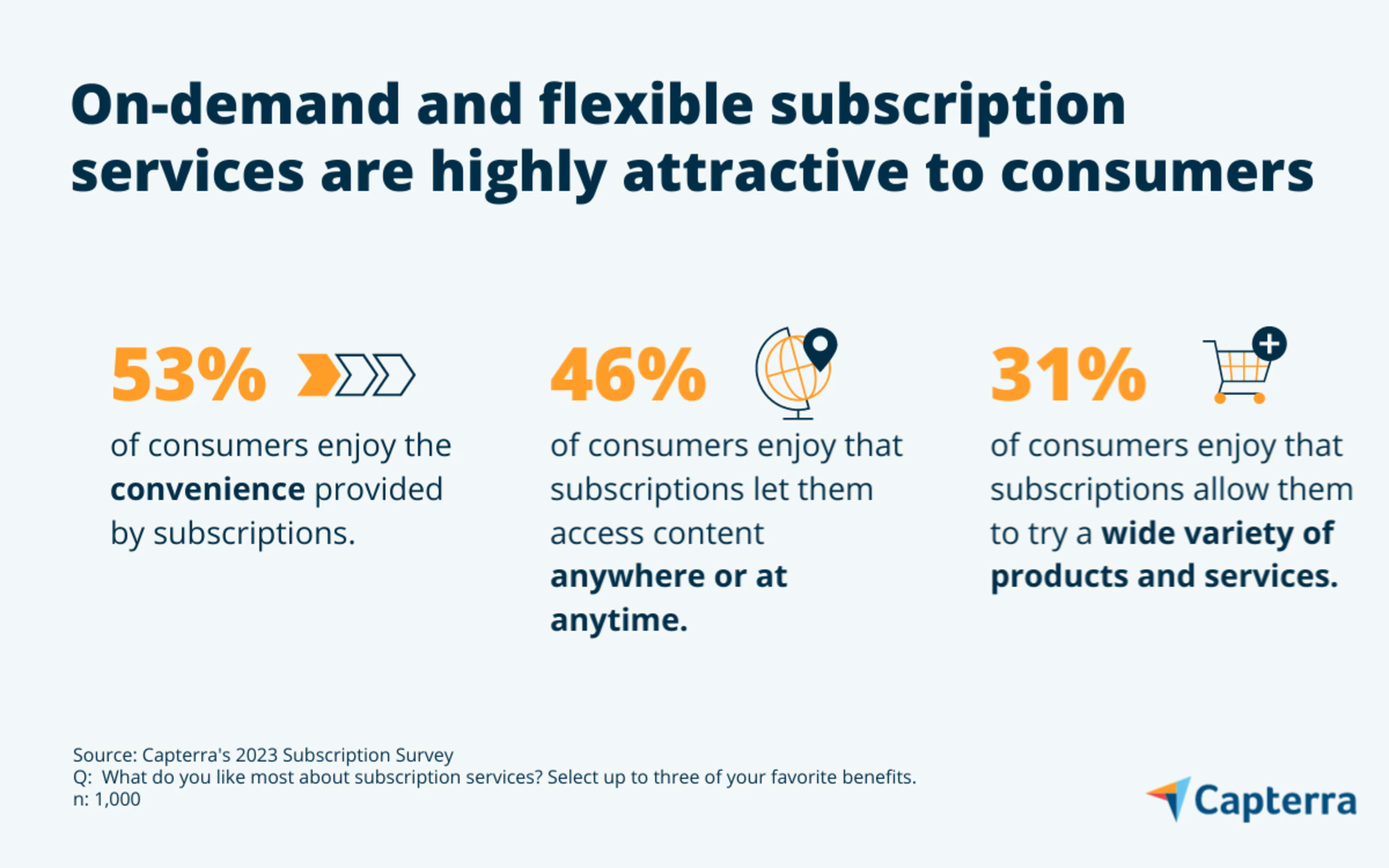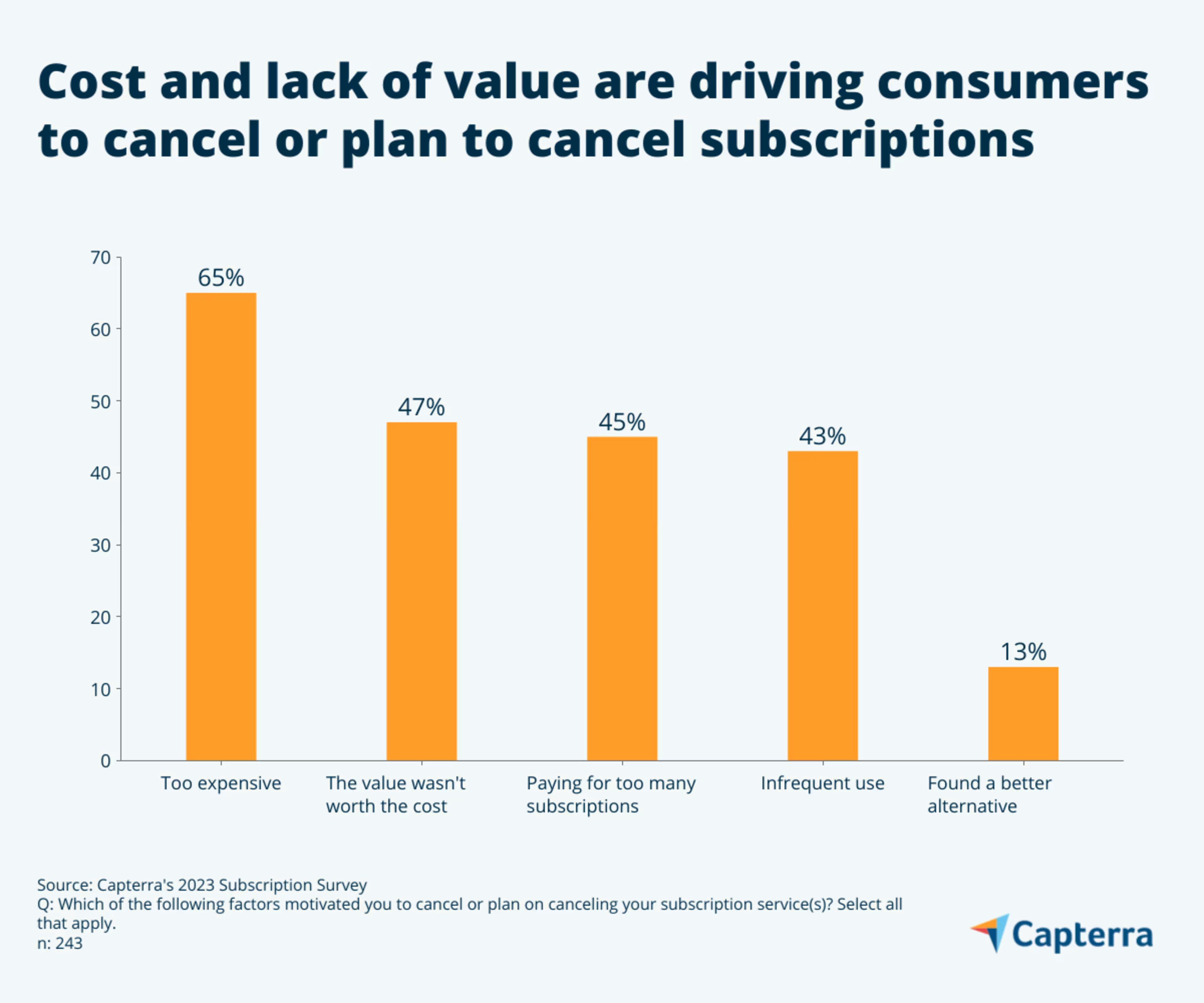76% of customers feel financial strain is causing subscription burnout—here's how to help
Many companies have seen success offering subscription services in recent years, and your business might be considering hopping on the bandwagon in the hopes of easily generating new sources of revenue. These models are increasingly popular, but before your company gets lost in the hype, it’s important to consider how consumers really feel about subscriptions.
According to Capterra’s 2023 Subscription Survey, 44% of consumers say they’re tired of using subscriptions for services. Among other things, they say this weariness is caused by an oversaturated market, financial strain, and the pains that go along with managing and keeping up with multiple subscriptions.*
Consumers are rethinking their relationship to subscriptions and it’s important that your company—whether you offer these services or plan to in the future—remain aware of their preferences in an increasingly saturated market. Our analysis can help you determine if this sales model is a good fit for your company or assist you in adjusting operations so that you can ensure that your subscription offerings keep you and your customer's best interests at heart.
Key findings
Consumers subscribe to, on average, three plans at a time and spend around $44 a month on subscriptions, in total.
99% of respondents say they see value in subscription services, prizing personalized content that gives them exclusive and convenient access to goods or services.
42% share that they’ve canceled a plan in the last 90 days; the leading reasons for cancellations were feeling like the value of the subscription wasn’t worth the cost and that it was too expensive.
38% say that if one of their current subscriptions increased in price, they would cancel it.
What does the typical subscriber want?
Our survey shows that—whether it’s software, entertainment, or everyday necessities—the typical subscriber of today yearns for affordable, flexible, and easily accessible experiences. User-friendly interfaces, straightforward sign-up and cancellation processes, and convenient services that can be used virtually anywhere or at any time are attractive to the modern consumer, who has little patience for subscriptions that are a hassle to manage or navigate.
Media-related and delivery subscriptions dominate consumer interest
Consumers have access to a vast array of subscription services that cover everything from personal finance to pet care. Media subscriptions (e.g., gaming, movies, music, books) have the strongest foothold on the market—72% of consumer respondents say they have active subscriptions in this category.
Looking at specific types of subscription services, streaming platforms remain the golden child of the industry, with 84% of respondents currently enrolled in these plans. A little over half of consumers say they’re actively using music or retail delivery services. Gaming plans, though relatively new, are popular with roughly a third of respondents.

On average, consumers say they currently pay for three plans, estimating that this costs them $44, in total, per month. Additionally, respondents share that the more plans they pay for, the less likely they are to actively use all the subscriptions at their fingertips. Excluding things such as boutique services or meal kits, most subscription plans offered by businesses charge consumers around $5 to $20 and are billed on a monthly cycle.
/ Key takeaway
The above metrics give businesses a good baseline for plan pricing, but it’s important to highlight that certain services, such as news subscriptions, are billed on a more frequent cadence given the exclusive access to content and timely nature they provide. Plan lengths should always be a consideration for businesses, as should buying options—mobile and other forms of digital payments have become popular with consumers, and many businesses report that supporting a wide spectrum of payment options has improved the overall customer experience they provide.
Exclusive, convenient, and customizable experiences appeal to consumers
Gartner research shows that subscription services saw accelerated growth during the pandemic, and estimates that by 2024, subscriptions will contribute to nearly a quarter of revenue growth for digital commerce organizations.[1] Findings from our survey strengthen the likelihood of these projections, as 99% of consumers share that they find value in subscription models, which highlights how popular and attractive these services remain today.
Some of the features consumers say they like most about subscriptions relate to media services—such as streaming platforms—with 46% appreciating that they can access content on-demand and close to a third savoring that they can eliminate ads from their experience.
On a broader scale, businesses should note that consumers enjoy the convenient nature of subscription services—eliminating their need for regular trips to the store, bundling products together at cheaper prices, and giving them access to experiences across devices are examples of this. They also prize being able to personalize their subscriptions and find value in experiences that provide them with perks such as exclusive access to content.

These three aspects are features that, regardless of industry or service, every subscription service should strive to provide consumers. Though the market is rife with competition, 55% of respondents say they’re likely to pick up a new subscription in the next six months, and highlighting these features can help attract consumers on the hunt for easy-to-use services with robust experiences that go beyond generic offerings.
/ Key takeaway
Consumers crave convenient and customizable experiences, but sometimes the value of these subscription services doesn't make itself readily apparent without smart advertising. If you don’t broadcast your product on the right channels and elegantly showcase its value at first blush, you might find yourself lost in a saturated market. Though many respondents discover new subscriptions through online advertising and search engines, 58% source services via social media or through friends or family. Introducing family plans or discounts for existing customers can encourage them to organically market your product, and working with a creative agency can help you ensure that advertising is short, sweet, and social-media friendly.
Tiered models and flexible pricing can prevent customer cancellations
Forty-two percent of consumers share that they have canceled one of their subscription plans in the past 90 days. Over half of consumers say businesses make the cancellation process difficult.

For respondents that either canceled a plan in the past 90 days or planned to cancel a plan by the end of 2023, 65% say it’s because the service was too expensive. Many businesses will likely have to pass some costs along to customers due to inflation, high interest rates, and a rocky economy—but it would be remiss for organizations to ignore the effects of a potential subscription price hike.
Beset by higher standards of living, the return of student loan repayments, and other economic headwinds that’ve compounded in the last few months, consumers share that they have little tolerance for subscription providers that plan to bump rates—38% say that if one of their current subscriptions increased in price, they’d cancel their subscription outright, compared to only a small minority that would be willing to shoulder costs.
A little less than half of consumers did note that they’d move to a lower-cost subscription tier if price increases became a reality. Overall, 80% of respondents say they prefer tiered models that offer flexible pricing as opposed to flat-fee subscriptions.
/ Key takeaway
Not every product lends itself well to a subscription model or tiered package. Gathering customer feedback, conducting a financial analysis of your current sales system, and assessing the flexibility of your current offerings are just a few strategies your company can pursue to see if it’s time to adopt, adjust, or move away from subscription services. Offering various plans or tiered models can help customers stretch their dollar and allow businesses to prevent customer churn in the midst of economic pressures.
44% of consumers say they’re burnt out by subscriptions—here’s how you can alleviate their fatigue and prevent churn
Discounting consumers’ preferences and attitudes surrounding subscriptions can lead to weak subscription programs with low ROI or customer churn and dissatisfaction. Here are some strategies you can implement to alleviate consumers' weariness surrounding subscriptions:
1. Establish loyalty programs and find opportunities to offer deals
Consumers say that financial strain is the number one factor contributing to subscription fatigue. While many customers would likely appreciate it if businesses could lower the costs of plans, the current economy makes this tricky without negatively impacting your bottom line. Leveraging regular discounts and promotions and establishing loyalty programs can keep recurring revenue steady, and be selectively used as incentives for new customers to sign up or encourage existing customers to stay.
2. Offer multiple ways to buy your services and use notifications
Keeping up with renewal dates is a struggle for 43% of consumers, and managing and accessing multiple plans tainted the subscription experience for a similar percentage. Experiment with various billing options (one-time purchases, pay-per-use, or usage-based methods) to give consumers more flexibility without having to commit more than they want to. Give them the ability to pause or suspend their subscriptions and keep them apprised of costs via recurring billing notifications so that it’s easier for them to control and monitor their plans.
3. Offer personalization options
Though a majority of customers prefer tiered subscription plans, close to a third find themselves frustrated by these models as they can sometimes lock content and services behind paywalls. Without sacrificing this structure or forcing costs upon them, consider ways in which you can let them customize their experience so that they can access the content they want. Allowing them to select a certain number of features based on their tier rather than having features dictated for them can let them curate their experience in a cost-effective manner.
Ensure your subscription service is successful by aligning yourself with consumers’ wants and needs
Standing out in a saturated market can enable your business to capitalize on the many benefits subscription sales models can provide, but this effort will only be successful if you stay in tune with customers' changing attitudes and preferences.
Whether you’re looking to streamline your recurring billing process or need assistance with managing customer relations, software can help you remain agile and ready to provide the convenient and flexible subscriptions consumers crave.
Economic forces and shifting preferences will no doubt change what consumers expect from businesses in the coming year, so be sure to prepare yourself by checking out our latest research that explores the trends that will define the financial sector in 2024.

